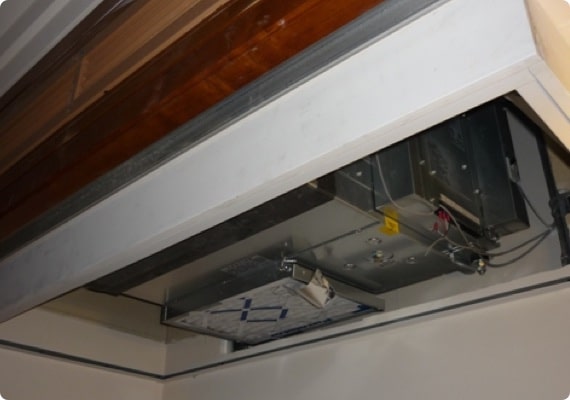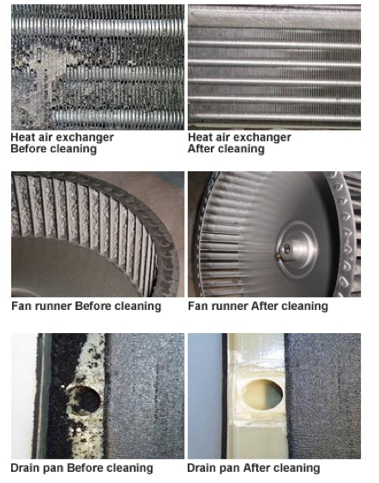| P1 | Drain Alarm | Detects water in drain pan and issues the alarm. |
| P2 | Anti – freeze alarm | Detects abnormal lowering of cold/hot water temperature and issues the alarm. |
| P3 | High load alarm | Detects high load state of compressor operation and issues the alarm. |
| P4 | Abnormality of fan motor | Detects abnormal overheating of fan motor and issues the alarm. |
| P5 | Detection of reverse phase | Detects reverse phase connection of power source and issues the alarm. (In case of power source with 3 phase) |
| P6 | Defrosting alarm | Detects abnormal lowering or icing of air heat exchanger and issues the alarm. |
| P7 | Overcurrent alarm | Detects over current of compressor and issues the alarm. |
| P8 | Abnormality of welding | Detects the welding of contacts of magnetic relay and issues the alarm. |
| L1 | Compressor error | Detects abnormal temperature of compressor and issues the alarm. |
| L2 | Abnormality of high pressure | Detects abnormal pressure inside the coolant piping and issues the alarm. |
| L3 | Abnormality of high pressure gas temperature | Detects abnormal overheating of coolant gas and issues the alarm. |
| L4 | Detection of current transformer defect | Detects malfunction of current transformer and issues the alarm. |
| L5 | Detection of open phase | Detects open phase and issues the alarm. (In case of power source with 3 phase) |
| L6 | Detection of panel connection defect | Detects poor connection of connectors of panel and issues the alarm. |
| E1 | Abnormality of switch system communication | Detects an abnormality, including snapping or short circuit between the unit, and switches and issues the alarm. |
| E2 | Abnormality of inter unit communication | Detects an abnormality, including snapping or short circuit of communication wires between the base machine and unit, and issues the alarm. |
| E3 | All-systems communication problems | Detects an abnormality, including snapping or short circuit of communication wires of entire system (between the unit and switches and between units), and issues the alarm. |
| E4 | Abnormality of number of unit connected | Alarm will be issued in case more than the specified number of unit and group are connected. |
| E5 | Abnormality of inverter communication | Detects an abnormality, including snapping or short circuit of communication wires between main circuit board and inverter module, and issues the alarm. |
| E6 | Detection of receipt of external signal | Alarm will be issued in case the extension unit directly received start/stop signal from outside. |
| E7 | Abnormality of model setting | Alarm will be issued in case the set model information was incorrect. |
| E8 | Abnormality of duplicated address | Alarm will be issued in case there are duplicated unit addresses within the same system. |
| E9 | Multiple connection of base setting switch | Alarm will be issued in case the LCD panel set as base unit or multiple slim remote controllers are connected to one unit. |
| F1 | Pre expansion valve thermistor | Detects snapping and short circuit of thermistors and issues the alarm. |
| F2 | Water heat exchanger inlet thermistor | Detects snapping and short circuit of thermistors and issues the alarm. |
| F3 | Heat source water inlet thermistor | Detects snapping and short circuit of thermistors and issues the alarm. |
| F4 | High pressure gas temperature thermistor | Detects snapping and short circuit of thermistors and issues the alarm. |
| F5 | Room temperature thermistor | Detects snapping and short circuit of thermistors and issues the alarm. |
| F6 | Low pressure gas temperature thermistor | Detects snapping and short circuit of thermistors and issues the alarm. |
| F7 | Room coil thermistor | Detects snapping and short circuit of thermistors and issues the alarm. |
| F8 | Heat source water outlet thermistor | Detects snapping and short circuit of thermistors and issues the alarm. |
| F9 | Outlet temperature thermistor | Detects snapping and short circuit of thermistors and issues the alarm. |
| H1 | Over current error | Inverter module detects over current and issues the alarm. |
| H2 | Temperature error | Inverter module detects abnormal overheat and issues the alarm. |
| H3 | Voltage error | Inverter module detects abnormality of supplied power and issues the alarm. |
| H4 | Serial communication alarm | Inverter module detects the interruption or abnormality of communication from the main circuit board and issues the alarm. |
| H5 | Temperature sensor error | Inverter module detects the short circuit of sensor and issues the alarm. |
| H6 | INV load error | Inverter module detects the short circuit of inverter output and issues the alarm. |
| H7 | Abnormality of model setting of inverter | Alarm will be issued in case the set model information of inverter module was incorrect. |

Maintenance and Preventive Maintenance
We strongly recommend that you establish a regular maintenance and inspection program for your heating and air conditioning equipment. Routine maintenance will help to:
- Ensure peak performance
- Extend the life of the product
- Keep operating costs low
- Prevent failure
- Ensure comfortable, safe operation for many years.
As with any electrical equipment, regular maintenance and inspection will help to identify parts and wires that may have deteriorated over time, and reduce the risk of fire and other safety hazards.
View Frequency of Maintenance Table (PDF)
Coolant Recycling/Disposal:
The unit contains coolant, which requires proper disposal and must not be discharged into the environment. Please comply with all local laws and relevant regulations related to maintenance and/or disposal of the unit, its parts and coolant in order to protect the environment.

Recommendations for Exchanging and Washing Filters
Dirty filters can cause a variety of problems, including:
- Inadequate cooling and heating
- Low air volume
- Water leaks due to freezing or condensation
- Errors due to system overload
- Odors
- Elevated operating current
Filter Replacement
We recommend regular replacement and cleaning of the filter to avoid problems.
Washing the Air Filter
In order to maintain a comfortable indoor environment and to keep the air conditioning unit working well for a long time, it is essential to exchange and wash the air filter on a regular basis. Using dirty or old filters (beyond their service life) can lead to a variety of problems, including:
- Reduced environmental quality due to increased levels of dirt and dust
- Lower operating efficiency
- Increased electricity (current) usage, which can overload the electronics and cause failure
- Increased operating costs.
We recommend establishing and following a regular care and maintenance plan to extend the life of your equipment, keep your costs low, and maintain the highest quality indoor environment.
Repair and Service Recommendations
Reconditioning or replacing damaged or dirty components will help extend the life of the equipment and maintain peak performance.
Performance Maintenance
After extended use, all air conditioning units become dirty, as shown below. This can lead to a variety of problems:
- Increased dust and dirt
- Decreased cooling capacity
- Increased power consumption
There is a chance that dirt accumulating inside the air conditioning will be expelled again after about five to ten years, depending on the condition and structure of the building, the amount of usage, the presence of coarse particulates, and operation time.
Control Unit
Parts which contain electrical contacts (such as the electro-magnetic switch) are especially susceptible to deterioration caused by electrical arcing when switching on and off. These parts should generally be replaced about every seven years, although this depends on operation times and conditions. If left untreated, the contacts may melt, leading to the failure of expensive components such as the compressor.
Mechanical Parts
Moving parts such as fan motor bearings, four way valve coils, three way valve, etc., have an expected operating life set by the manufacturers. If this is exceeded, performance may become erratic and decline and various faults and sudden failures etc., will occur, resulting in more frequent problems for customers.
